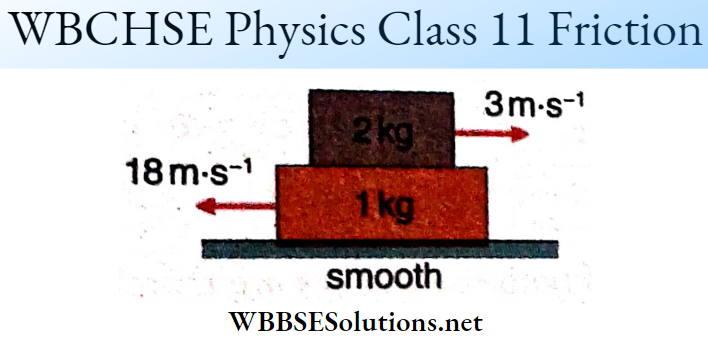Law of Motion Class 11 Notes Physics
Laws Of Motion – Friction
Friction Introduction: It is a common experience that, when a book lying on a table is pushed, it moves some distance and then stops. However according to Newton’s first law of motion, after being pushed, the book should have continued moving with a uniform velocity in the absence of any external force.
- The fact that the book stops clearly shows the existence of some external force that affects the motion of the body. This force is the force of friction, or simply friction, or dry friction. Also, if the book is pushed slightly, it often does not move at all.
- If the force on the book is gradually increased, it begins to move after a while. So, initially, the frictional force can balance the applied force. But, later, it is not enough to resist the motion.
- A large number of phenomena in our daily lives, prove the existence of frictional force. Discussions in this chapter will be restricted to friction between two dry surfaces only.
Read and Learn More: Class 11 Physics Notes
Friction Definition: When two surfaces are in contact with each other and there exists a relative motion between them or an attempt is made to impart a relative motion, then a force comes into play that resists this motion or this attempt. This force is called the force of friction, or simply, friction.
The respective areas of the two bodies which remain in contact with each other are called the surfaces of contact. Friction acts parallel to the surfaces of contact in a direction opposite to the direction of relative motion that is attempted or actually occurs.
Origin Of Friction: From our experience, we find that friction between two smooth surfaces is less than that between two rough surfaces. An apparently smooth surface when examined under a powerful microscope, also shows considerable roughness on the atomic scale.
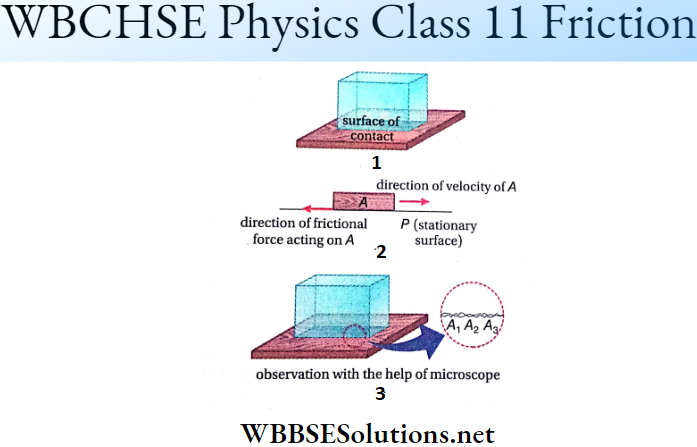
- At the points of contact A1, A2, and A3,……. atoms of the two surfaces come very close to each other, and interatomic forces act between them. Hence, adhesion takes place between the planes. Such adhesion is the source of friction.
- Also, due to the relative motion between the surfaces, the shape and size of the grooves change continuously. This creates waves and atomic motion which also give rise to friction.
Law of Motion Class 11 Notes Physics
Class 11 Physics Notes For Angle Of Repose
Consider a body of weight W, placed on a surface inclined at an angle θ with the horizontal. The normal force of the inclined plane on the body is R = W cosθ. In this case, the component W sinθ along the plane tries to set up a downward motion of the body.
- Consequently, a frictional force develops upwards along the surface. If the inclination θ is such that the surface just prevents the downward motion of the body, then the frictional force f is the limiting friction, expressed as f = W sinθ.
- Hence, the coefficient of friction, \(\mu=\frac{f}{R}=\frac{W \sin \theta}{W \cos \theta}=\tan \theta\)
- Therefore, when the tangent of the angle of inclination equals the coefficient of friction, the body remains in limiting equilibrium on the inclined plane. If the angle of inclination θ is increased further, W sinθ also increases.
- Then the limiting friction f cannot balance the body and it starts to slide down the inclined plane. The angle of inclination θ in this case, is called the angle of repose of the inclined plane.
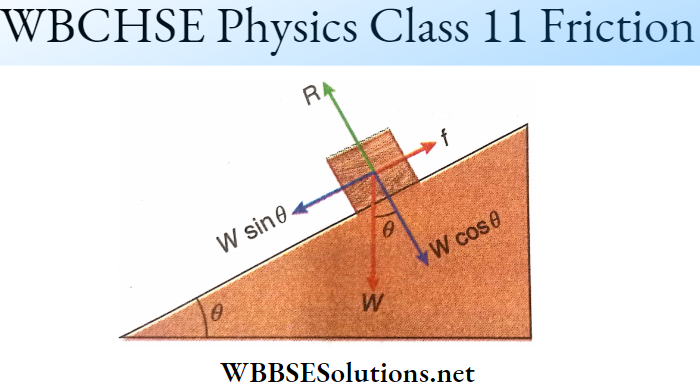
Angle Of Repose Definition: The maximum value of the angle of inclination of a surface, for which an object placed on it is just on the verge of downward motion due to its own weight, is called the angle of repose.
Law of Motion Class 11 Notes Physics – Angle Of Repose Discussion
- For a very smooth surface, i.e., for μ ≈ 0, the angle of repose becomes approximately equal to 0°. This means that the surface cannot prevent the downward motion of this body, even when it is very slightly inclined.
- When the angle of inclination exceeds the angle of repose, then the frictional force can no longer keep the body in equilibrium on the inclined plane.
- The angle of repose of different objects, placed on the same inclined surface, may be different.
- We know μ = tanλ, where λ is the angle of friction, and also μ = tanθ, where θ is the angle of repose, for a pair of surfaces in contact.
∴ tanλ= tanθ or, λ = 6.
Thus, the angle of repose and the angle of friction are numerically equal. However, they are two different physical quantities. The angle of friction is a quantity related to friction between any two surfaces; on the other hand, the angle of repose is a property of inclined surfaces only.
Law of Motion Class 11 Notes Physics – Acceleration Of A Body On An Inclined Plane
Consider a body of mass m sliding down an inclined plane with an acceleration a. Let the angle of inclination be θ. Since the body slides down, θ must be greater than the angle of repose.
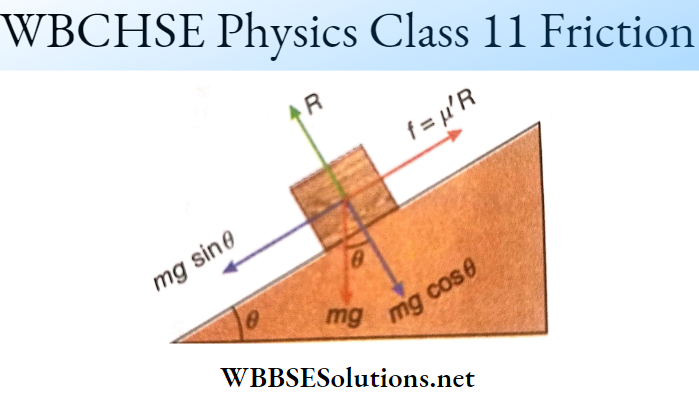
Here kinetic friction acts upwards along the incline. Let the normal force of the inclined plane be R, and the coefficient of sliding friction be μ’. Hence, sliding frictional force, f = μ’ R.
Also, R = mgcosθ. The component of the weight of the body along the plane is mg sinθ, which is in the opposite direction of f. The equation of the downward motion, of the body along this inclined plane is, mg sinθ-f= ma
or, ma = mg sinθ – μ’R = mg(sinθ-μ’cosθ)
or, a = g(sinθ-μ’cosθ)
If the inclined plane is perfectly smooth, then μ’ = 0 and a = g sinθ. Hence, the frictional force reduces the downward acceleration of the body along the plane by an amount gμ’ cosθ.
Equilibrium Of A Body On An Inclined Plane
A body of weight W is kept on a plane inclined at an angle θ with the horizontal. If θ is greater than the angle of repose, the frictional force alone is not sufficient to keep the body at rest; an external force F is required for equilibrium. Let it be assumed that the force F makes an angle α with the inclined plane.
There can be either of the two limiting equilibrium conditions—
- The body is about to move down along the inclined plane, or,
- The body is about to move up along the inclined plane.
Case 1: Equilibrium Against Downward Motion: The force of limiting friction acts on the body in an upward direction. For equilibrium, the resultants of the components of the forces acting
- Along The Incline, And
- Perpendicular To The Incline, Both Should Be Zero.
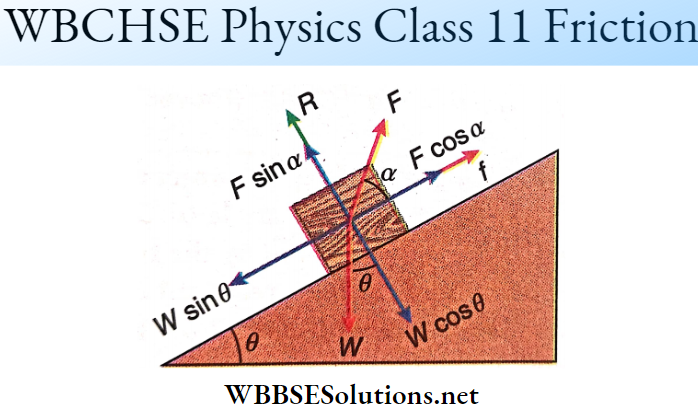
Here, f + F cosα = W sinθ …(1) and
R + F sinα = W cosθ …(2)
If the coefficient of friction is μ, then f = μR and from equation (1), μR+ F cosα = W sinθ …..(3)
Multiplying equation (2) by θ and then subtracting from (3) we get,
∴ \(F(\cos \alpha-\mu \sin \alpha)=W(\sin \theta-\mu \cos \theta)\)
or, \(F=W \cdot \frac{\sin \theta-\mu \cos \theta}{\cos \alpha-\mu \sin \alpha}\)
Again, if \(\lambda\) is the angle of friction then, \(\mu=\tan \lambda\)
∴ F = \(W \cdot \frac{\sin \theta-\tan \lambda \cos \theta}{\cos \alpha-\tan \lambda \sin \alpha}\)
= \(W \cdot \frac{\sin \theta \cos \lambda-\cos \theta \sin \lambda}{\cos \alpha \cos \lambda-\sin \lambda \sin \alpha}\)
= \(W \cdot \frac{\sin (\theta-\lambda)}{\cos (\alpha+\lambda)}\)…(4)
For given values of θ and λ, F wdll be minimum when cos(α +λ) is maximum,
i.e., when cos(α +λ) = 1 = cos 0
∴ a + λ = 0 or, λ = -λ ….(5)
∴ Minimum applied force, Fmin – W sin(θ – λ)
Class 11 Physics Friction Notes
Case 2: Equilibrium Against Upward Motion: If the body is about to move up along the incline, the limiting friction, f= μR acts downwards along the incline. The forces acting when the body is just about to move are shown. Conditions for limiting equilibrium are,
F cosα = μR + W sinθ or, F cosα-μR = W sinθ…..(6)
and F sinα + R = Wcosθ or, μF sinα + μR = W μcosθ…..(7)
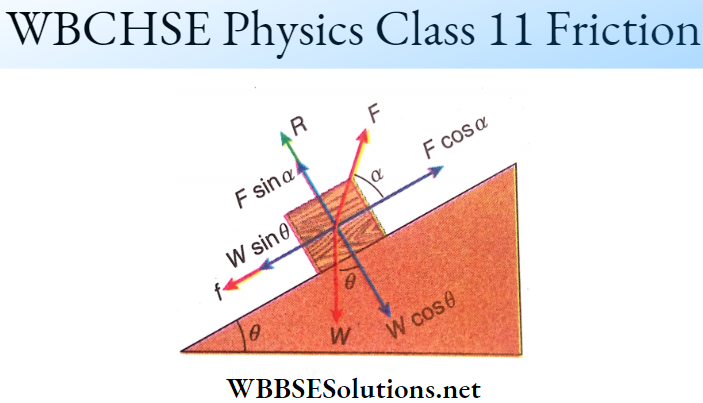
On adding (6) and (7), we get F(cosα + μsinα) = W(sinθ + μcosθ)
or, F = \(W \cdot \frac{\sin \theta+\mu \cos \theta}{\cos \alpha+\mu \sin \alpha}\)
Expressing μ in terms of the angle of friction λ, i.e., μ = tanλ,
F = \(W \cdot \frac{\sin \theta+\tan \lambda \cos \theta}{\cos \alpha+\tan \lambda \sin \alpha}\)
= \(W \cdot \frac{\sin \theta \cos \lambda+\sin \lambda \cos \theta}{\cos \alpha \cos \lambda+\sin \lambda \sin \alpha}\)
= \(W \cdot \frac{\sin (\theta+\lambda)}{\cos (\alpha-\lambda)}\)
For given values of θ and λ for F to be minimum, cos(α-λ) = 1 = cos 0 or,α = λ
Class 11 Physics Friction Notes
and Fmin = W sin(θ + λ).
Special Cases: When F is applied along the plane, i.e., if α = 0, then the force required to prevent the body from moving downwards is F = \(W \cdot \frac{\sin (\theta-\lambda)}{\cos \lambda}\)…(9)
Again, the force required to bring the body on the verge of moving upwards along the inclined plane is F = \(\frac{W \sin (\theta+\lambda)}{\cos \lambda}\)…(10)
Equilibrium Of A Body On An Inclined Plane Numerical Examples
Example 1. A body is kept on a horizontal rough plane. The plane is then gradually raised to an inclination of 30° with the horizontal and the body starts to slide down. The body descends 12 m along the inclined plane in the next 4 s. Find the coefficients of static and magnetic friction between the surfaces in contact.
Solution:
In this case, the angle of repose = 30°.
∴ Coefficient of static friction, μ = tan30° = 1/√3 = 0.577
As the body begins to slide down, kinetic friction starts acting against the motion.
Downward acceleration, a = g(sinθ-μ’cosθ) [μ’ = coefficient of kinetic friction]
= \(9.8\left(\frac{1}{2}-\mu^{\prime} \frac{\sqrt{3}}{2}\right)=9.8\left(0.5-0.866 \mu^{\prime}\right) \mathrm{m} \cdot \mathrm{s}^{-2}\)
As the body travels 12 m in 4 s from rest, from the equation, s = \(\frac{1}{20}\) at², we get,
12 = \(\frac{1}{2} a \cdot(4)^2 \quad \text { or, } a=\frac{3}{2}=1.5 \mathrm{~m} \cdot \mathrm{s}^{-2}\)
∴ \(9.8\left(0.5-0.866 \mu^{\prime}\right)=1.5\)
or, \(4.9-8.5 \mu^{\prime}=1.5 \quad \text { or, } \mu^{\prime}=\frac{3.4}{8.5}=0.4\)
Class 11 Physics Friction Notes
Example 2. To initiate an upward motion of a body along an inclined plane, the minimum force required is twice the force required to keep the body at rest on the same incline. If the coefficient of friction is μ, prove that the inclination of the plane is θ = tan-1 (3μ).
Solution:
Let the mass of the body be m, and the minimum force required to keep the body at rest on the inclined plane be F1.
In this case, the force of limiting friction f acts in the direction of the applied force.
∴ F1+f=mgsinθ
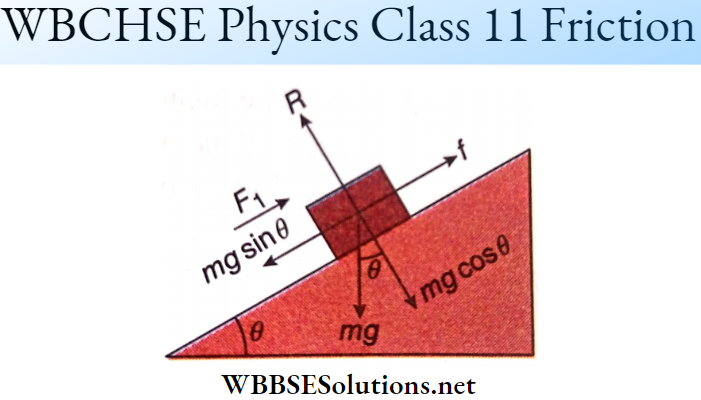
or, F1 + μmg cosθ = mg sinθ or, F1 = mg(sinθ – μcosθ). If F2 is the minimum force needed to set the body in an upward motion, then limiting friction acts downwards.
∴ F2 = mg sinθ + f = mg sinθ + μmg cosθ
= mg(sinθ +μcosθ)….(1)
As F2 = 2F1 (given),
mg(sinθ + μcosθ) = 2mg(sinθ- μ cosθ) or, sinθ = 3 μ cosθ
or, tanθ = 3μ or, θ = tan-1(3μ) (Proved).
Example 3. A body of mass 5 x 10-3 kg is projected upwards along a plane inclined at an angle of 30° with the horizontal. If the time required by the body to move up the incline is half the time required for it to slide down, find the coefficient of friction between the surface and the body.
Solution:
Let the mass of the body be m, and its upward acceleration be a1. Let the force of friction be f.
∴ ma1 = mg sinθ + f = mg sinθ + μmg cosθ
or, a1 = g(sinθ + μcosθ)
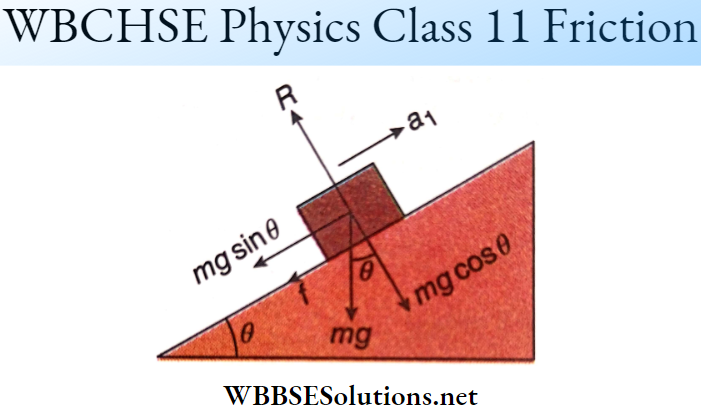
If a2 is the acceleration during the downward motion, then, ma2 = mgsindθ – f = mgsinθ – μmgcosθ
or, a2 = g(sinθ-μcosθ)
Class 11 Physics Friction Notes
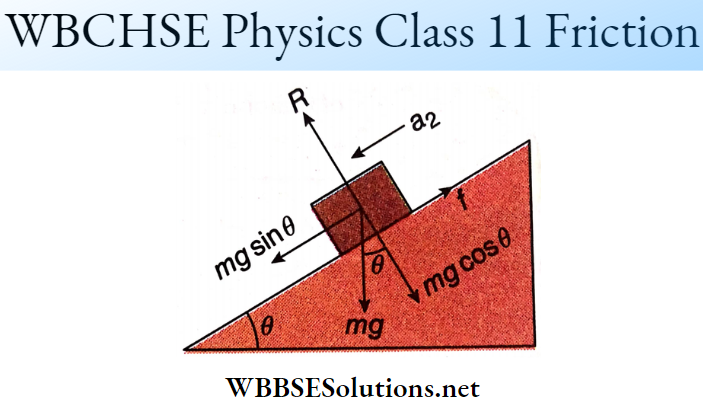
∴ \(\frac{a_1}{a_2}=\frac{\sin \theta+\mu \cos \theta}{\sin \theta-\mu \cos \theta}=\frac{\tan \theta+\mu}{\tan \theta-\mu}\)
If the displacement along the inclined plane is s, and the time taken to move up and to come down are t1 and t2 respectively, then,
s = \(\frac{1}{2} a_1 t_1^2=\frac{1}{2} a_2 t_2^2\)
∴ \(a_1=\frac{2 s}{t_1^2} \text { and } a_2=\frac{2 s}{t_2^2}\)
⇒ \(\frac{a_1}{a_2}=\frac{t_2^2}{t_1^2}=\left(\frac{t_2}{t_1}\right)^2=2^2=4 \quad\left[because t_1=\frac{t_2}{2}\right]\)
∴ \(\frac{\tan \theta+\mu}{\tan \theta-\mu}=4 \text { or, } \mu=\frac{3}{5} \tan \theta=0.6 \tan 30^{\circ}=0.346\)
Example 4. The upper half of an inclined surface is perfectly smooth but the lower half is rough. A body starts sliding down the plane and stops immediately upon reaching the bottom. The inclination of the plane is 30° with the horizontal. Show that the frictional resistance of the rough part of the surface is equal to the weight of the body.
Solution:
Class 11 Physics Friction Notes
Let the length of the inclined plane be 2l, and the vertical height from the ground be h.
Then we get, \(\sin 30^{\circ}=\frac{h}{2 l} \quad \text { or, } \frac{1}{2}=\frac{h}{2 l} \quad \text { or, } h=l \text {. }\)
The potential energy of the body of mass m at maximum height on the plane = mgh = mgl.
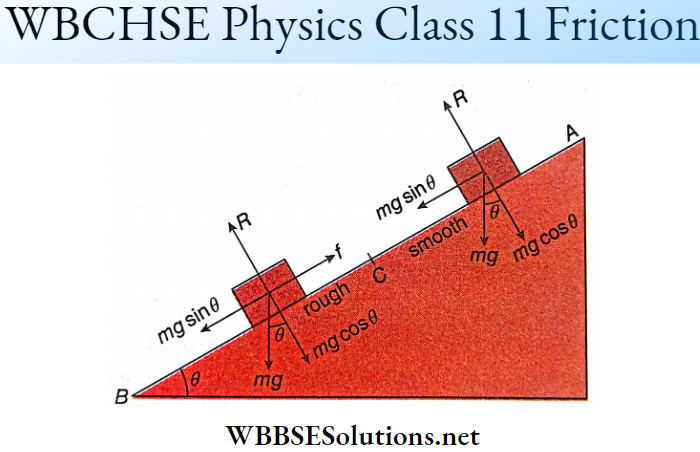
The body comes to rest at the bottom. Hence, all its potential energy at the top is spent in doing work against the force of friction, which acts along the length of the lower half of the surface. If f is the frictional force, then f x l = mgl
or, f = mg = weight of the body (Proved).
Rolling Friction
So far we have discussed only the examples of motions where a body slides over a surface. Common examples are, pulling a chair on a floor, skiing on ice, pushing a book over a table, and so on.
- A characteristic feature of this sliding motion is that the contact plane of the moving body remains unaltered. In other words, the force of friction acts on a particular surface of the sliding body all the time.
- When a body rolls over a surface, the area of contact of the rolling body changes continuously with time. So, the frictional force does not act on any specific surface of the body.
Types Of Friction
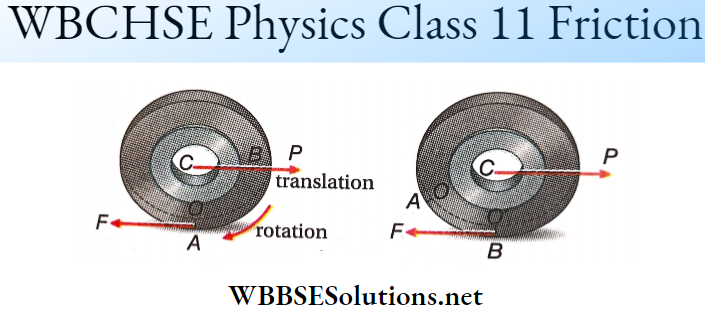
Consider the motion of a wheel over a horizontal plane. In this case the area of contact of the two surfaces at any time during the motion is very small.
- When a rigid (or hard) wheel is placed on a horizontal plane, the plane of contact practically becomes a straight line, Now, let a horizontal force P be applied at the center C of the wheel.
- It will initiate a translatory motion of the wheel, along the horizontal surface. Then, a frictional force F will act in the backward direction at the line of contact OA. As a result, the moment of F about C will generate a rotation of the wheel.
- Line OA will be displaced, and new lines like O’B will come in contact with the horizontal surface. The overall effect is that two types of motion (translational and rotational) are set up in the wheel. Such composite motion of the wheel is called rolling.
Rolling Friction Definition: When a body translates, as well as rotates over a surface without slipping, its motion is known as rolling; the frictional force developed opposite to the direction of motion is called rolling friction.
- We already know that sliding or kinetic friction is less than the limiting value of static friction (limiting friction). Rolling friction is much lower than even sliding friction. So it is considerably easier to overcome the rolling friction, and thus to set a body in motion.
- This is how all-wheeled vehicles move. Wheels and tracks are always designed so that the applied force is greater than the rolling friction but less than the sliding friction. Car and bicycle tires have grooved surfaces that increase sliding friction.
If, for some reason, the sliding friction suddenly drops below the applied force, the wheel of the bicycle slides, or ‘skids’. Vehicles with wheels are not used at all where the sliding friction is very low—for example, flat-bottomed carts are used on ice surfaces.
Source Of Rolling Friction: When a wheel rolls on a surface, its motion gets obstructed due to deformation of the wheel, the surface, or both, at the plane of contact.
Types Of Friction
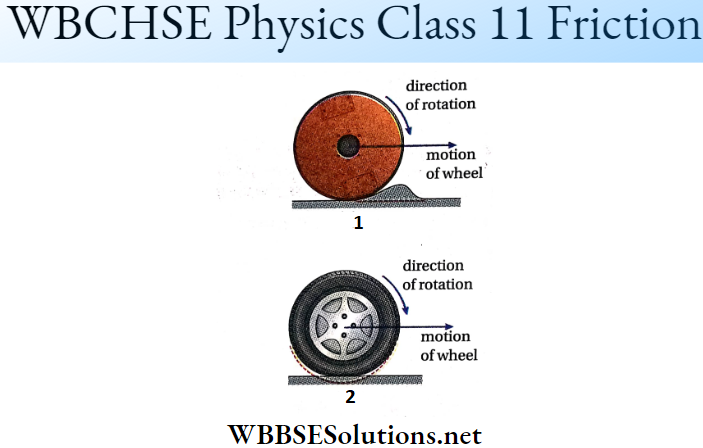
- In real life, usually, the and the ground are not perfectly rigid and both get deformed to some extent.
- Such deformation is easily noticeable when a heavy wheel rolls over soft ground. At the point of contact of the wheel and the ground, an indentation is created on the surface due to the weight of the wheel. The ground just in front of the wheel swells up slightly.
- At the point of contact, the wheel also gets deformed and a slight flattening is easily observed. These deformations at the point of contact are the source of rolling friction. When the air pressure is low in a cycle tube, the is flattened, and frictional force increases.
- If both the surfaces in contact are rigid enough, then the deformation is negligible, and so the rolling friction is quite low. For this reason, the friction is considerably low in the case of a train running over a railway track.
Note that, the deformations of the surfaces in contact, in case of a rolling motion, are temporary. As soon as the point of contact shifts, the wheel and the surface regain their original shapes and the deformation shifts to a new point of contact.
Difference Between Sliding Friction And Rolling Friction:
- The surface of contact remains unchanged in case of sliding friction while in case of rolling friction, the surface of contact keeps changing.
- In case of sliding friction, two surfaces in contact are in motion with respect to each other. In the case of rolling friction, there is no relative motion between the two surfaces in contact.
- The frictional force opposing the sliding motion (sliding friction) is much more than the force opposing the rolling motion (rolling friction).
Class 11 Physics Notes For Friction
Friction Conclusion
When two surfaces are in contact with each other, and there exists a relative motion between them, or an attempt is made to impart a relative motion, a force comes into play that resists the movement. This force is called the force of friction, or simply friction.
- Force of friction is a self-adjusting force that balances the applied force as long as there is no relative motion in which case it is known as static friction.
- The maximum possible magnitude of static friction is called limiting friction.
- The force of limiting friction and kinetic friction, between two surfaces in contact, are directly proportional to the normal force.
- When the normal force remains constant, friction between the two surfaces in contact is independent of the area of contact and the relative velocity between the surfaces.
- The ratio between the force of limiting friction and the normal force is called the coefficient of static friction for two surfaces in contact. Again, the ratio between the kinetic friction and the normal force is the coefficient of kinetic friction.
The coefficient of friction (μ) does not have any unit; it is just a number. Usually, it is less than 1, but can be equal to or greater than 1 in special cases.
- For a pair of surfaces in contact the resultant of the force of limiting friction and the normal force makes an angle with the normal force itself. That is called the angle of friction.
- The maximum value of the angle of inclination of an inclined plane, for which an object is just on the verge of downward motion along the incline only due to its weight is called the angle of repose.
- For the same system, the angle of friction is equal to the angle of repose.
- When a body rolls over a surface without slipping, the frictional force developed at the point of contact, that opposes the rotation of the rolling body, is called rolling friction.
Friction Useful Relations For Solving Numerical Examples
When R = normal force, f = limiting friction or sliding friction, and μ = coefficient of friction, f = μR,
Acceleration produced on a body of mass m, kept on a rough surface, by a force F applied along the surface, is a = \(\frac{F-\mu R}{m}\)
If a body of mass m remains in equilibrium on a plane, inclined at the angle of repose θ, then R = mg cosθ and f = μR= mg sinθ; hence, μ = tanθ.
If the angle of repose is θ and the angle of friction is λ then, μ = tanθ = tanλ
∴ θ = λ.
Resultant of the limiting friction and the normal force R between two surfaces in contact,
Q = \(R \sqrt{1+\mu^2}\)
Acceleration of a body moving over an incline, under the action of gravity is a = g(sinθ – μcosθ)
Friction Very Short Answer Type Questions
Question 1. Can the value of the coefficient of friction be greater than 1?
Answer: Yes
Question 2. Does the force of friction depend on the area of contact?
Answer: No
Question 3. On what factors does the coefficient of static friction depend?
Answer:
- Nature of the surfaces in contact
- Nature of the material in contact
Question 4. What is wet friction?
Answer: The force of friction between a solid and the layer of liquid
Question 5. Value of the angle of friction ______ on increasing the smoothness of the plane.
Answer: Decreases
Question 6. Rolling friction is _______ than both static friction and kinetic friction.
Answer: Less
Friction Assertion Reason Type Question And Answers
These questions have statement 1 and statement 2. Of the four choices given below, choose the one that best describes the two statements.
- Statement 1 is true, statement 2 is true; statement 2 is a correct explanation for statement 1.
- Statement 1 is true, and statement 2 is true; statement 2 is not a correct explanation for statement 1.
- Statement 1 is true, statement 2 is false.
- Statement 1 is false, and statement 2 is true.
Question 1.
Statement 1: If a body tries to slip over a surface then friction acting on the body is necessarily equal to the limiting friction.
Statement 2: Static friction can be less than the limiting friction.
Answer: 4. Statement 1 is false, statement 2 is true
Question 2.
Statement 1: Frictional heat generated by the moving ski is the chief factor that promotes sliding in skiing and waxing the ski makes skiing easier.
Statement 2: Due to friction, energy dissipates in the form of heat. As a result, it melts the snow below it. Wax is water-repellent.
Answer: 1. Statement 1 is true, statement 2 is true; statement 2 is a correct explanation for statement 1.
Question 3.
Statement 1: The coefficient of friction can be greater than unity.
Statement 2: Frictional force depends on normal reaction and the ratio of force of friction and normal reaction cannot exceed unity.
Answer: 3. Statement 1 is true, statement 2 is false.
Question 4.
Statement 1: Static frictional force is always greater than the kinetic frictional force.
Statement 2: Coefficient of static friction, μs > coefficient of kinetic friction, μk.
Answer: 4. Statement 1 is false, statement 2 is true
Question 5.
Statement 1: The driver of a moving car sees a wall in front of him. To avoid a collision, he should apply brakes rather than take a turn away from the wall.
Statement 2: Force of friction is needed to stop the car or take a turn on a horizontal road.
Answer: 2. Statement 1 is true, statement 2 is true; statement 2 is not a correct explanation for statement 1.
Question 6.
Statement 1: Friction opposes the motion of a body.
Statement 2: Static friction is self-adjusting while kinetic friction is constant.
Answer: 2. Statement 1 is true, statement 2 is true; statement 2 is not a correct explanation for statement 1.
Question 7.
Statement 1: A particle is thrown vertically upwards. If air resistance is taken into consideration then retardation in the upward journey is more than the acceleration in the downward journey.
Statement 2: Some mechanical energy is lost in the form of heat due to air friction.
Answer: 2. Statement 1 is true, statement 2 is true; statement 2 is not a correct explanation for statement 1.
Friction Match Column A With Column B
Question 1.
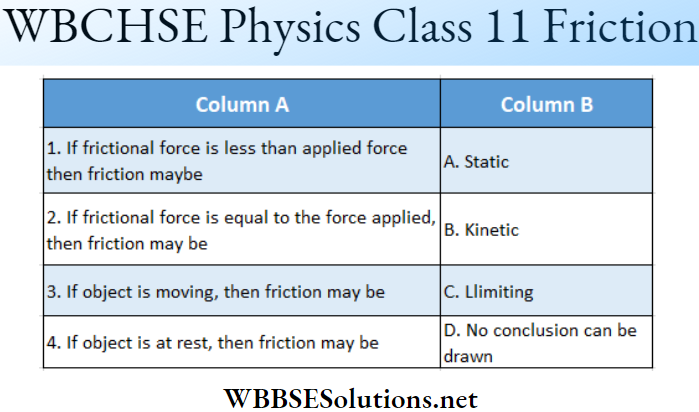
Answer: 1. B, 2. A, C, 3. B, 2. A, C
Question 2. For the situation shown, in Column A, the statements regarding frictional forces are mentioned, while in Column B some information related to frictional forces is given.

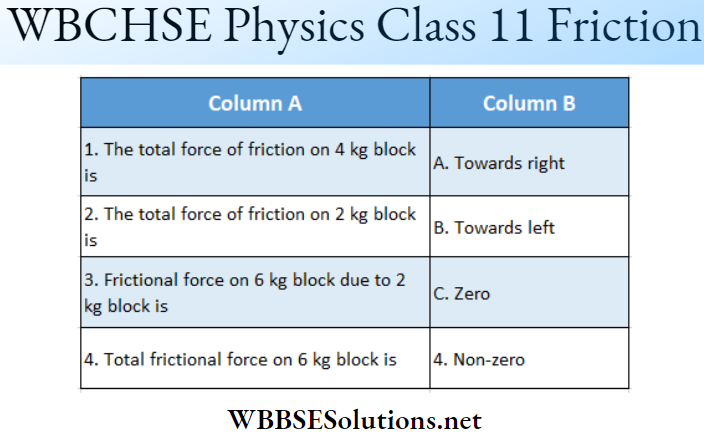
Answer: 1. B, D, 2. C, 3. A, D, 4. C
Question 3. A body of mass 200 g is moving with a velocity of 5 m • s-1 along the positive x -x-direction. At time t = 0, when the body is at x = 0, a constant force of 0.4 N directed along the negative x-direction is applied to the body for 10 s.
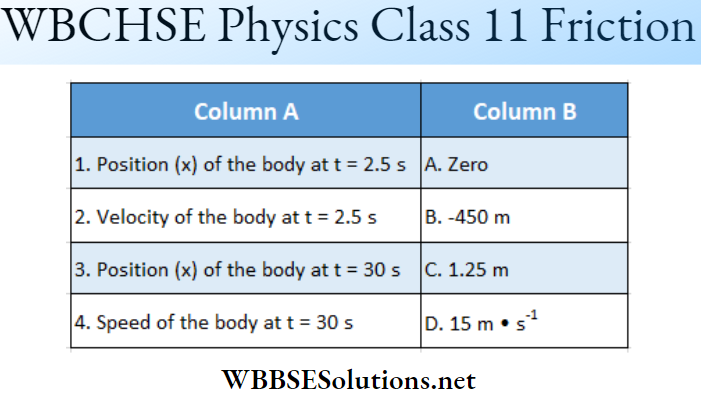
Answer: 1. C, 2. A, 3. B, 4. D
Question 4. The coefficient of friction between the block and the surface is 0.4.
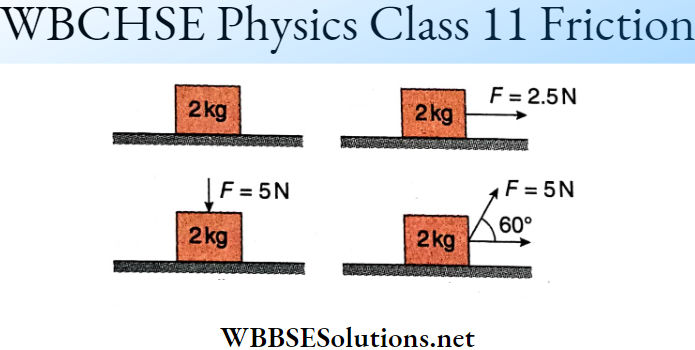
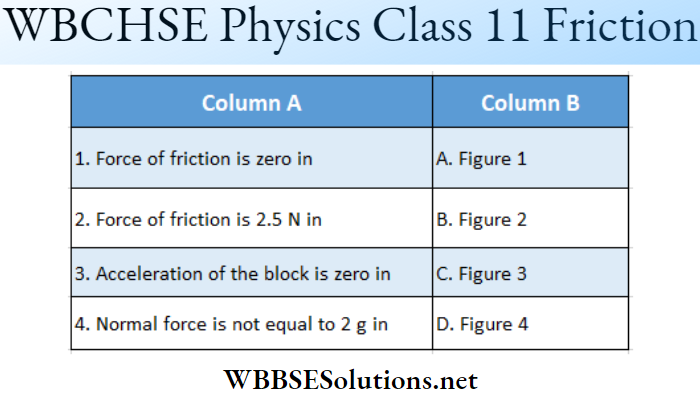
Answer: 1. A, C, 2. B, D 3. A, B 4. C, D
Question 5. Both the pulleys are massless and frictionless. A force F (of any possible magnitude) is applied in the horizontal direction. There is no friction between M and the ground. μ1 and μ2 are the coefficients of friction as shown between the blocks. Column A gives the different relations between μ1 and μ2 and Column B is regarding the motion of M.
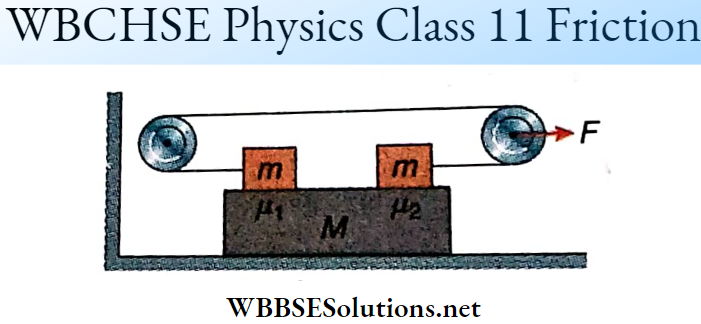
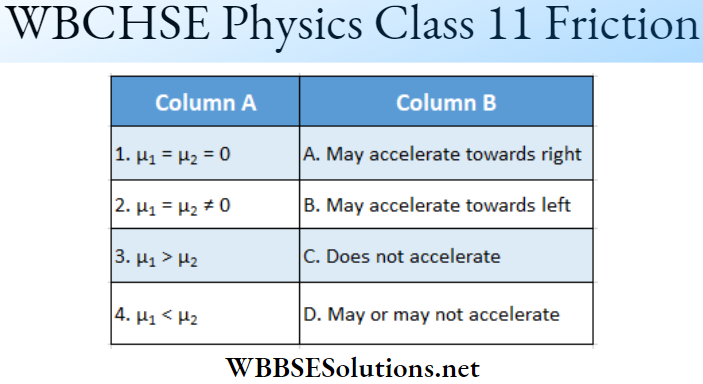
Answer: 1. C, 2. C, 3. B, D, 4. A, D
Question 6. For the diagram shown, match the following columns.
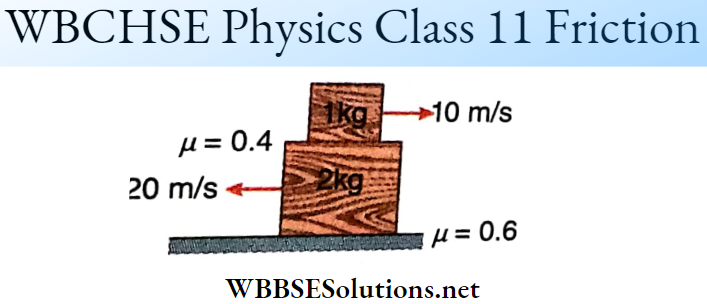
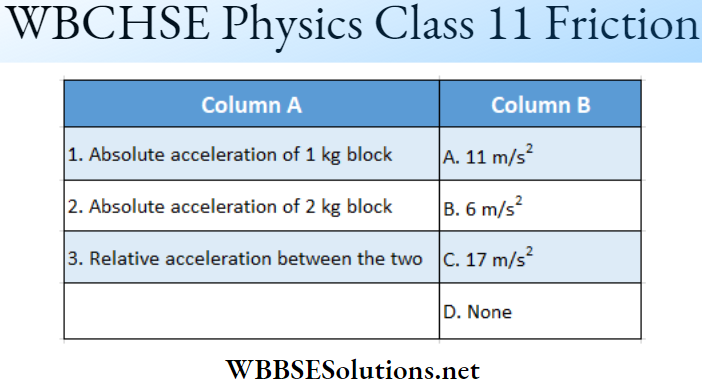
Answer: 1. D, 2. A, 3. D
Question 7. A block of mass m is thrown upwards with some initial velocity as shown. On the block:
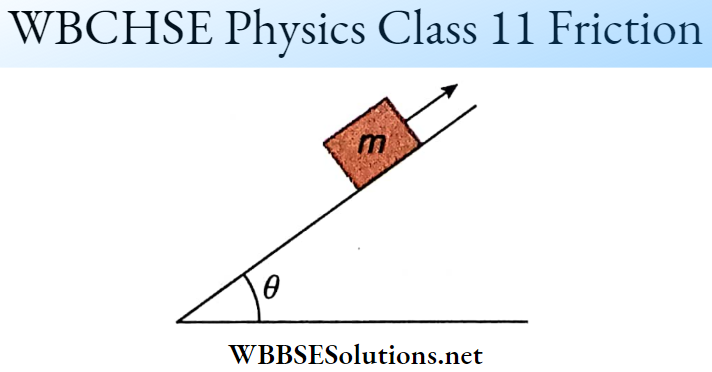
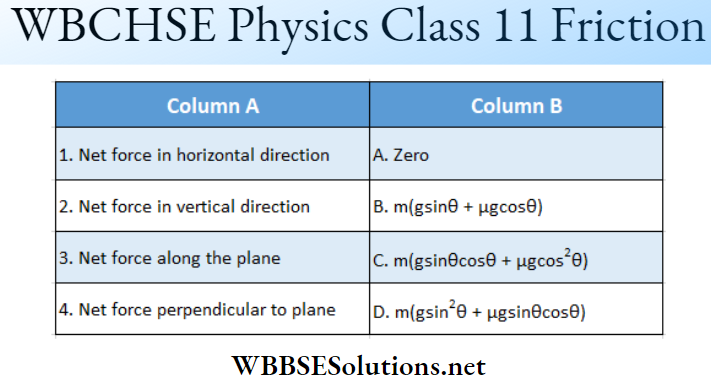
Answer: 1. C, 2. D, 3. B 4. A
Friction Comprehension Type Question And Answers
Read the following passages carefully and answer the questions at the end of them.
Question 1. A man wants to slide down a block of mass m which is kept on a fixed inclined plane of inclination 30° as shown. Initially, the block is not sliding. To just start sliding the man pushes the block down the incline with a force F. Now, the block starts accelerating. To move it downwards with constant speed the man starts pulling the block with the same force. Surfaces are such that ratio of maximum static friction to kinetic friction is 2.
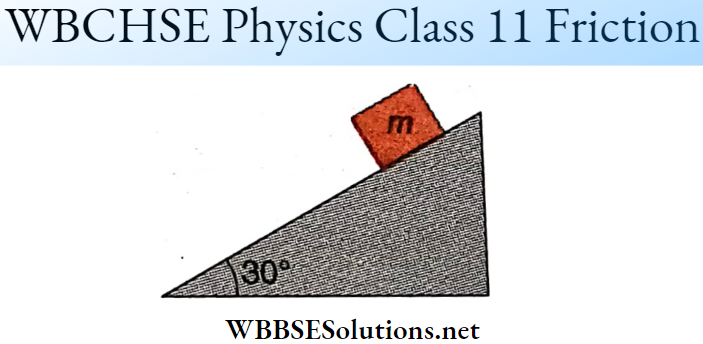
1. What is the value of F?
- \(\frac{m g}{4}\)
- \(\frac{m g}{6}\)
- \(\frac{m g \sqrt{3}}{4}\)
- \(\frac{m g}{2 \sqrt{3}}\)
Answer: 2. \(\frac{m g}{6}\)
2. What is the value of μs, friction?
- \(\frac{4}{3 \sqrt{3}}\)
- \(\frac{2}{3 \sqrt{3}}\)
- \(\frac{3}{3 \sqrt{3}}\)
- \(\frac{1}{2 \sqrt{3}}\)
Answer: 1. \(\frac{4}{3 \sqrt{3}}\)
3. If the man continues pushing the block by force F, its acceleration would be
- \(\frac{g}{6}\)
- \(\frac{g}{4}\)
- \(\frac{g}{2}\)
- \(\frac{g}{3}\)
Asnwer: 4. \(\frac{g}{3}\)
Question 2. A lift with a mass 1200 kg is raised from rest by a cable with a tension of 1350g N. After some time the tension drops to 1000g N and the lift comes to rest at a height of 25 m above its initial point. (1gN = 9.8 N).
1. What is the height at which the tension changes?
- 10.8 m
- 12.5 m
- 14.3 m
- 16 m
Answer: 3. 14.3 m
2. What is the greatest speed of the lift?
- 9.8 m s-1
- 7.5 m s-1
- 5.92 m s-1
- None Of These
Answer: 3. 5.92 m s-1
Question 3. A 6 kg block is kept on an inclined rough surface as shown. Based on this information answer the following questions (Take g = 10 m · s-2).
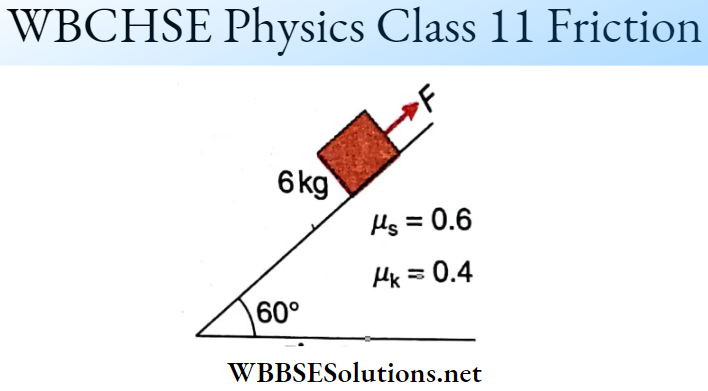
1. The amount of force (F) required to keep the block stationary is
- 34N
- 40 N
- 35 N
- 36 N
Answer: 1. 34N
2. The amount of force (F) required to move the block downwards with constant velocity is
- 35 N
- 37 N
- 40 N
- 44 N
Answer: 3. 40 N
3. The amount of force (F) required to move the block upwards with an acceleration of 4 m • s-2 is
- 90 N
- 92 N
- 88 N
- 80 N
Answer: 3. 88 N
Friction Integer Answer Type Questions
In this type, the answer to each of the questions li a tingle digit Integer ranging from 0 to 9.
Question 1. A horizontal force of 10 N is necessary to just hold a block stationary against a wall. The coefficient of friction between the block and the wall is 0.2. What is the weight of the block (in N)?
Answer: 2
Question 2. The coefficient of friction between two blocks is μ = 0.6. The blocks are given velocities in the directions shown in the figure. Find the common velocity (in m • s-1) of the two blocks.
Answer: 4
